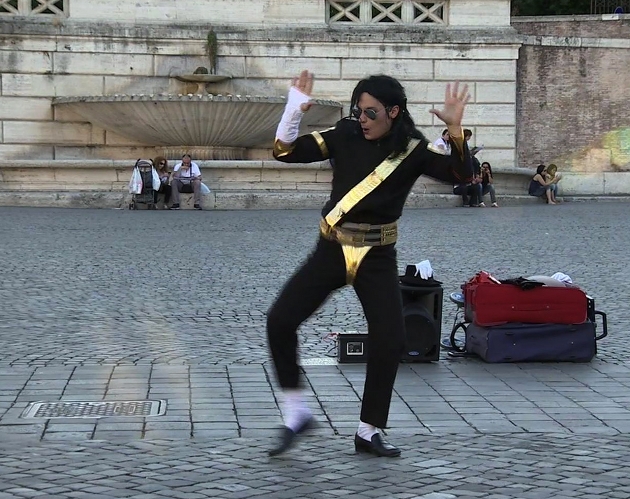
He twirls, he slides, he jumps, he kicks and twists and turns on the cobblestones of the Eternal City…it is Michael Jackson in Rome.
Twenty-nine year old Italian Emiliano Fiacchi is a Michael Jackson imitator who draws crowds by twisting and twirling to “Bad” , “Billy Jean” and “Beat it”.
Fiacchi has been a devoted fan of Michael Jackson since a classmate in elementary school first showed him a Jackson video. Over the years Fiacchi has studied Jackson’s moves and techniques with a combination of videos, and later DVDs, and mirrors so that he could imitate the legendary star.
While Michael Jackson’s stage was the world, Emiliano’s stage is Piazza del Popolo, one of the Rome’s largest and most picturesque spaces. There he sets up his amplifiers, pulls out his jackets and props, throws down his hat and he is ready to go.
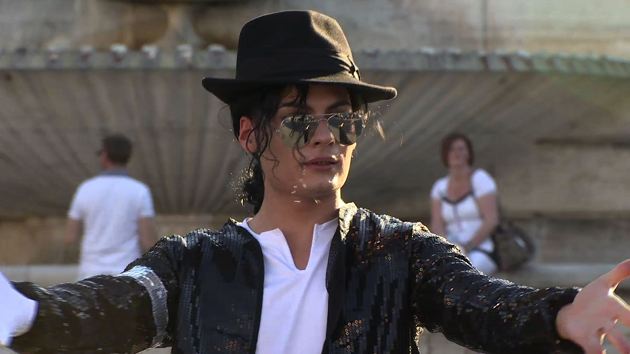
Fiacchi is one of the many artists who is taking his talents to the streets to boost their incomes in an economic crisis. According to statistics provided by the Italian Ministry of Culture, their budget has been cut by 141 million Euros over the past year, and since the year 2000 the cuts to culture have been roughly 600 million euros.
Fiacchi is supporting his small family – his wife and three-year-old son – on the 700-800 euros a month that he gets from his street work. There are no benefits, no help if he is sick or hurt, but he is still grateful to have the income in a moment when many young people in Italy are out of work. He says Rome is his city and he wouldn’t want to perform any other place, but he thinks if his son wants to fulfill his dreams he will need to leave Italy.
According to Fiacchi “if my son wants to reach any of his dreams– it can be becoming a doctor, or a veterinarian, or an artist, whatever he wants, he will have to do it outside this country. It is a given that the best we send away because here in Italy there is no opportunity, unfortunately we don’t even keep our best minds here, they always go and work abroad.”
The city government says there is a total of 287 registered street artists performing in Rome. But there are many more unregistered performers.
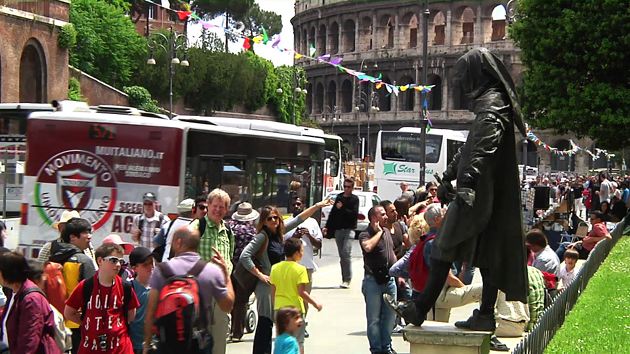
Adam Zbigniew Gasecki from Poland is a registered artist who specializes in being a statue of Cola di Rienzo, Italy’s famed medieval leader who wanted to restore Rome to its ancient greatness. His virtues are extolled in the poems of Petrarch. The real statue of Cola di Rienzo stands near Rome’s City Hall, but Gasecki’s version is much more popular, attracting throngs of tourists as they make their way past the Roman forum towards the Coliseum.
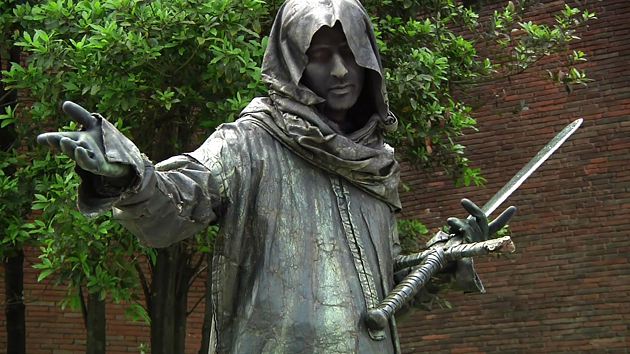
Gasecki says he chose Cola di Rienzo because he wanted a young, romantic, historic Italian figure. He has now been performing for eight years. Gasecki works hard to maintain his costume and make his performance (mostly standing absolutely still) special. The statue’s slow movements, whether with his sword or his eyes, are calculated and practiced. The base of his costume is cotton, but it took him two weeks of work to paint it with acrylic paints to get the right worn metallic look. Gasecki says he works roughly 140 days a year in Rome and makes enough money to get by, but he has noticed a dramatic drop in the amount of money going into his hat in the past few years.
Other street artists have less elaborate costumes. Many immigrants seem to be trying to make some money to get by rather than practicing an art. On a typical sunny day in Rome, a decidedly unenthusiastic Statue of Liberty stands in front of a statue of Julius Caesar and a tired Spiderman takes a break.
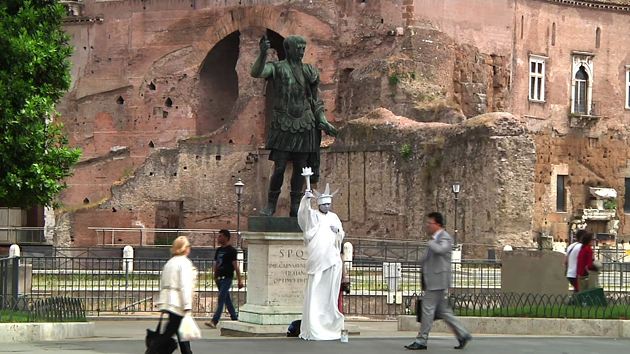
A golden pharaoh stands still in the shadow of the Coliseum, and a headless figure with glasses waves to tourists near the Trevi Fountain. Many of these street artists are foreigners who don’t have licenses and quickly pick up their costume and leave when the traffic cops come down the street, none of them wanted to be interviewed by me. Then there are the famed Gladiators who hang out outside the Coliseum and ask tourists anywhere from 5-25 euros to get their photo taken.
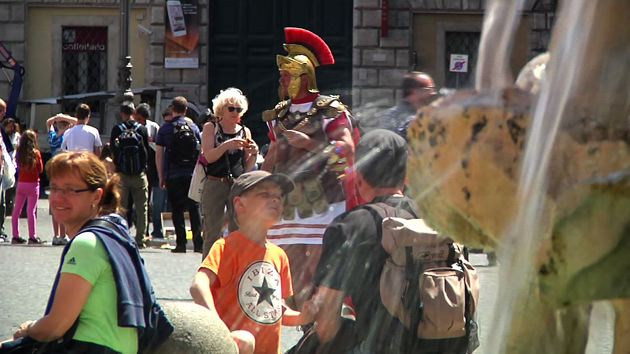
Street artists say that Rome is a fantastic city in which to work because the weather is good for street performances many months of the year, the piazzas are welcoming, the Romans are enthusiastic and there are lots of tourists.
Maria Grazie Fiore is the coordinator of an organization of street artists called “Streets Free for All.” Her street art is dedicated to kids and involves a performance with gigantic bubbles. According to Fiore: “for a street artist, Rome is a beautiful city, but not because you read it in the history books or in magazines, Rome is truly a beautiful city, big, spacious. The Romans have this sense of popular vernacular, this pat on the shoulder, this “aaooo Mario”, everyone knows us on the street, the Roman people love the street artists, because Rome is one of the first cities where people started doing art for “the hat”, we are talking about going back to the Roman Empire.”
However, over the past few years there have been a few problems with the city government. Under former Mayor Gianni Alemanno, the city put a limit of two hours on street artists. Artists must register in advance with the traffic police when they are planning to perform in some of the city’s designated performance spots in key piazzas. The city also banned amplifiers. This ban was a huge problem for Fiacchi who said he can’t imitate Michael Jackson without his music.
Fiore explains that “Streets Free for All” took their case to the courts and this spring they won their case. They are now allowed to perform with amplifiers. Artists are also hoping that Ignazio Marino, Rome’s newly elected Mayor, will be more appreciative of their work and flexible with the regulations, especially the two hour limit. Fiacchi notes that most people wouldn’t earn enough to live on if they were only allowed to work two hours a day.
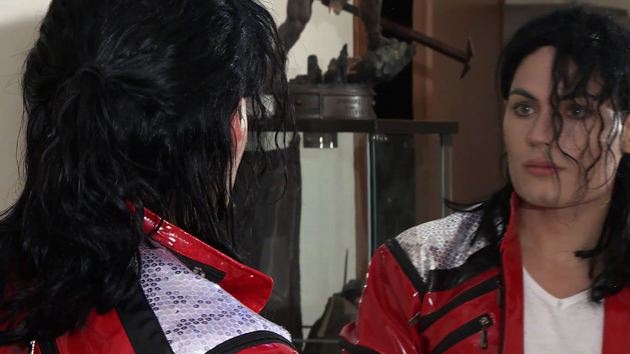
In his home on the outskirts of Rome, Fiacchi is preparing for another afternoon in Piazza del Popolo. It takes time to transform himself into Michael Jackson. He begins with the base make-up, puts on eye-liner and mascara. He then puts a net over his hair and places a specially-made “Michael Jackson” wig on top. He carefully adjusts the locks that fall over his face. Fiacchi explains that his look is that of Michael Jackson in the period when he performed “Bad”. Once he has prepared his look, Fiacchi takes his suitcase with his amplifiers and various outfits, jackets, hats, gloves, belts and crotch decorations to Piazza del Popolo.
He turns on the music, puts down his hat and begins his Michael Magic as the crowd slowly gathers.
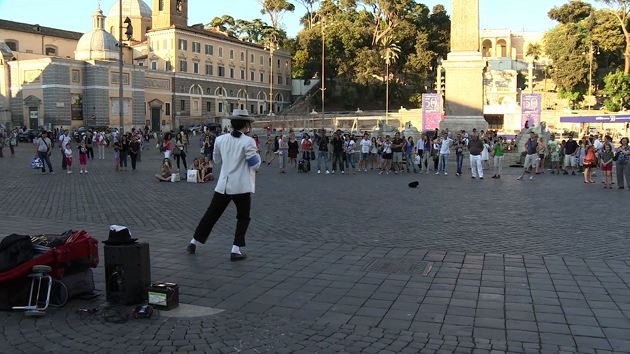

the authorities are often just a bunch of miserable ‘Jobsworfs’ (‘it’s more than me jobs worth) – brighten places up I say and let the performers perform their magic.
the authorities are often just a bunch of miserable ‘Jobsworfs’ (‘it’s more than me jobs worth) – brighten places up I say and let the performers perform their magic.
I agree!! Bring on the magic 24/7 I love the street performers!!
Well, how wonderful. I had no idea there were so many street performers. It sounds like there is an entire subculture of people who make their living at this. Near where I live in Los Angeles s the famous Venice boardwalk area where there are all sorts of performers. Does Rome have anything to rival our guy who juggles chainsaws??
Fiacchi looks much more normal than MJ
Yes, I would say so. Michael Jackson was not very “normal”, but I think he was a “genius” at his art. What is amazing to see is Emiliano Fiacchi without the makeup and wig. He doesn’t look anything like Michael Jackson at all. The transformation he does is fantastic.
Fiacchi looks much more normal than MJ